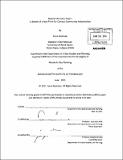| dc.contributor.advisor | Lawrence Vale. | en_US |
| dc.contributor.author | Bowman, Anne (Anne Renee) | en_US |
| dc.contributor.other | Massachusetts Institute of Technology. Dept. of Urban Studies and Planning. | en_US |
| dc.date.accessioned | 2011-11-01T19:56:30Z | |
| dc.date.available | 2011-11-01T19:56:30Z | |
| dc.date.copyright | 2011 | en_US |
| dc.date.issued | 2011 | en_US |
| dc.identifier.uri | http://hdl.handle.net/1721.1/66877 | |
| dc.description | Thesis (M.C.P.)--Massachusetts Institute of Technology, Dept. of Urban Studies and Planning, 2011. | en_US |
| dc.description | Page 119 blank. Cataloged from PDF version of thesis. | en_US |
| dc.description | Includes bibliographical references (p. 110-118). | en_US |
| dc.description.abstract | The terms "ivory tower" and "town-gown" have long been used to characterize the relationship between institutions of higher education and the communities in which they reside. While these adversarial phrases reflect the social and physical tension that has historically existed between the two groups, the terms are no longer appropriate as colleges and universities of today are more enlightened, realizing that as fixed and vested institutions, much of their success, and in some cases survival, is dependent on the health of the community in which they reside. The American college campus, where design decisions have come about as a means to engender community and promote learning, is a physical manifestation of the institutional mission and purpose. Therefore, as institutions look beyond their campus edges to consciously engage with their larger community, a shift in the physical representation should follow. In this thesis, I examine the evolution of a new physical form that reflects this changing dynamic by exploring the alignment of the institution's mission to the design and development of the campus edge, where this relationship is most evident. Based on a review of current campus conditions, I develop a sequence of edge conditions based on permeability and relationship between campus and community. I then focus on urban institutions in marginalized neighborhoods that have expanded their mission by embracing their urban setting and engaging with their communities in comprehensive revitalization initiatives. Using two case studies, Clark University and Trinity College, and drawing briefly on several other examples, I consider the relationship between the current and historical mission of the institution and the impact their recent neighborhood revitalization efforts have had on the physical transformation of the campus edges. Applying lessons learned from these efforts, I encourage colleges and universities to reconsider the value of their edges and promote them as an integral part of the overall campus. Finally, I make recommendations to help institutions rethink their campus edges in a way that embraces the evolving community-university dynamic and contributes to the well-being of both their students and surrounding neighborhood. | en_US |
| dc.description.statementofresponsibility | by Anne Bowman. | en_US |
| dc.format.extent | 119 p. | en_US |
| dc.language.iso | eng | en_US |
| dc.publisher | Massachusetts Institute of Technology | en_US |
| dc.rights | M.I.T. theses are protected by
copyright. They may be viewed from this source for any purpose, but
reproduction or distribution in any format is prohibited without written
permission. See provided URL for inquiries about permission. | en_US |
| dc.rights.uri | http://dspace.mit.edu/handle/1721.1/7582 | en_US |
| dc.subject | Urban Studies and Planning. | en_US |
| dc.title | Beyond the ivory tower : in search of a new form for campus-community relationships | en_US |
| dc.title.alternative | In search of a new form for campus-community relationships | en_US |
| dc.type | Thesis | en_US |
| dc.description.degree | M.C.P. | en_US |
| dc.contributor.department | Massachusetts Institute of Technology. Department of Urban Studies and Planning | |
| dc.identifier.oclc | 758240181 | en_US |

